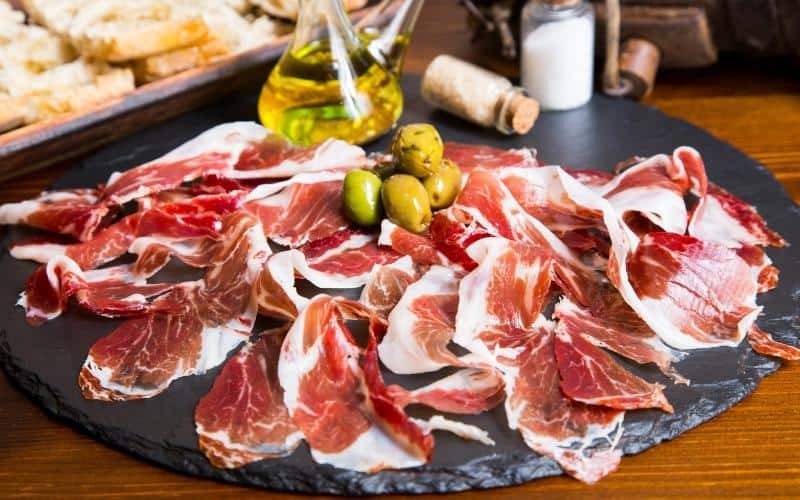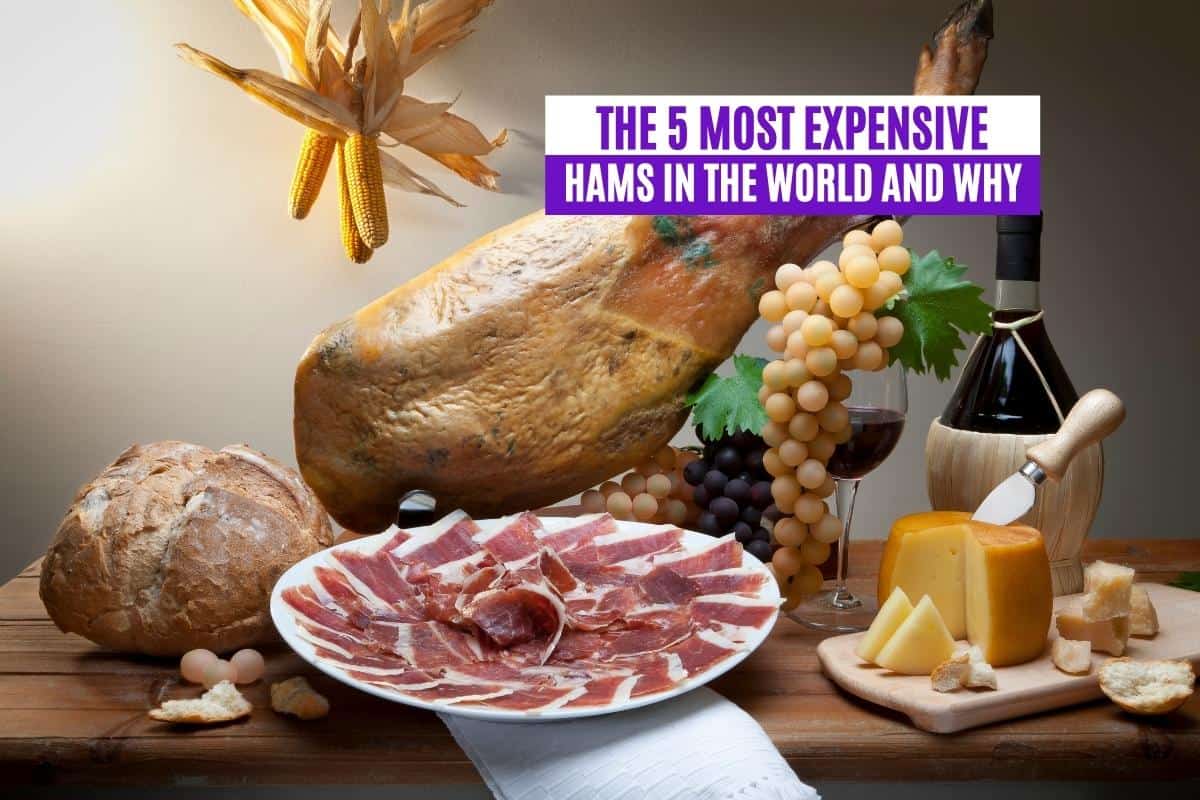What kind of ham costs thousands of dollars?
Whether you actually intend on buying expensive lunch meat or are simply intrigued by the world’s finer things, learning about luxury hams can help you dream big when it comes to future dinner parties.
But what’s so premium about these hams? What factors into their steep prices?
Below, we’ll explain what determines a ham’s price, the signs of good ham options, ham’s health benefits, and what the world’s top five expensive hams are. Afterward, you might add the most expensive ham in the world to your bucket list.
Why are Hams So Expensive?
Two different ham products still come from the same type of animal — pigs. But the agricultural and manufacturing processes that produced these hams determine the price tag difference.
Higher quality care generally produces higher quality meat. Some pigs eat better diets that affect the meat’s flavor and have more room to roam.
Accommodating these conditions is expensive and disallows farmers from being able to fit many pigs in a small space. Therefore, these producers cannot make many hams at a single time. Lower supply and higher quality of care tick up ham products’ price tags.
Ham curing also affects the price, as curing requires additional amenities and takes a long time. It’s also a delicate process involving continuous monitoring of pH and humidity levels. Some hams take years to properly cure by the manufacturer’s standards.
Generally, high-quality hams cannot be mass-produced. Instead, they are priced and eaten like delicacies, not easily accessible to those without considerable financial means.
What Are the Signs of a Good Ham?
To tell the difference between a low-quality ham and a luxury ham, first understand the variety of hams available. The common denominators for determining the qualities of hams involve resource usage, time spent, and quality of care of the pigs raised.
Cut
The cut itself doesn’t indicate the meat’s quality, but some cuts are more palatable to a wider variety of people. Some people prefer ham shanks because of their higher fat content, while others prefer ham butts since they’re leaner and easier to slice.
The flavor of bone-in hams is superior since they impart better flavor and texture. However, some people are more than willing to sacrifice that flavor for the convenience of an easy slice.
Cure
Hams are either fresh or cured. There are two different types of curing — wet-curing, also known as brining, and dry-curing. Cured hams are pricier due to the intense labor and resource usage involved.
Wet-cured meats are brined then smoked. They’re also the most common types of ham sold. Dry-cured meats are covered in salt and left to cure.
Dry curing ham is a more traditional curing process. It’s also more laborious, though the effort ultimately results in a generally fuller flavor than wet curing.
Beyond that is the nature of the curing solution itself. The cure’s overall flavor may beat its competitors or contain high-quality ingredients. Both factors also add to a ham’s price tag.
Smoke
If ham is smoked at all, longer smoking produces better flavor. Smoking can happen from days to weeks. Longer smoking times indicate higher resource usage and result in more exquisite, expensive hams.
Age
Just as with curing and smoking, extended aging creates better flavor. After being cured and smoked, hung hams will be covered and left to age from anywhere between a few weeks to a few years to maximize their flavors. Better aging conditions with low humidity and correct pH balance will also factor into the ham’s price.
What Are the Health Benefits of Ham?
Ham provides several health benefits, doubling its function as both fuel and a delicious meal. Its benefits range from its micronutritional value to its muscle-building abilities.
Micronutritional Value
This meat is rich in essential micronutrients. Such nutrients include:
- Selenium, which has potent antioxidant and anticancer effects while preventing heart disease
- Carnosine micronutrients, which aid neurological function, protect against symptoms of diabetes, improve muscle function, and potentially fight cancer
- Choline, which regulates liver and brain functioning
Muscle Building
People who want to build bigger muscles benefit from eating more protein. Just enough protein can stave off viral infections and maintain muscle. But with more protein, the body can accommodate new tissue growth.
Protein’s muscle-repairing ability is also critical for muscle growth. Injured muscles cannot heal properly, and exercising them could exacerbate injuries. But protein speeds up muscle recovery, making room for bigger growth.
As a significant source of protein, ham is great for anyone trying to build muscle. A standard three-ounce serving of ham provides 18 grams of protein. This serving is roughly one-third of males’ daily protein allowance and almost half of females’ daily protein allowance.
Muscle Performance
Muscle size isn’t the only factor in muscle performance. Pork can improve muscle function since it contains carnosine. But not only does it improve muscle function, but it also lowers fatigue.
With lower fatigue and higher innate functioning, people can perform better while exercising. Doing so allows them to build even more muscle.
Fat Loss
Protein is excellent for both muscle-building and fat loss. There are many reasons for this, one of the chief reasons being that protein can speed up metabolism by building muscle.
Out of all macronutrients, protein is also the most satiating, which can prevent overeating. By eating a higher proportion of protein in their daily diets, individuals can satiate their hunger for longer and lose fat more easily.
Eating at a caloric deficit is challenging for most people. But when eaten with a higher proportion of protein, people can lose fat with less hunger.
Inflammation Relief
Not all hams are the same. Many hams pose risks of high blood pressure and heart disease — both of which involve symptoms of inflammation. But luxurious hams, notably of the Jamón Ibérico variety, may actually relieve inflammation because of the diet provided to the pigs.
World’s Top Five Expensive Hams
Nearly all of these expensive ham options hail from Spain. However, some of the hams listed are also produced in Portugal, albeit in smaller quantities. While you’ll learn a lot of general information about well-produced hams from this list, you’ll also get a good sense of how well Spain tends to its pigs and ham manufacturing processes.

5. Jamón Ibérico de Cebo
Jamón Ibérico de Cebo is white label Jamón Iberico that uses pigs that are usually 50-75% Ibérico. Each Jamón Ibérico de Cebo is cured for 24 months. The meat is also not free-range and pigs feed on a diet consisting only of grain.
Why It’s Expensive
Pigs with Iberian ancestry are both rare and capable of producing high-quality meat. Although Jamón Ibérico de Cebo does not use 100% Ibérico pigs, Iberian ancestry already sets a high price.
Jamón Ibérico de Cebo is considered the “worst” Jamón Ibérico on this list, but the manufacturing process is still much more attentive than conventional mass farming methods. Those who prefer a more moist ham and an affordable price tag may enjoy this delicacy.
4. Culatello di Zibello
Culatello is known for its usage and “disassembling” of only the posterior muscles of pigs’ thighs. It is also commonly mistaken as prosciutto, although the latter is taken from the pig’s inner thigh instead of the posterior thigh muscle. Curing takes around 12 months.
Unlike Jamón Ibérico’s ideally nutty flavor, Culatello is lightly sweet and almost imperceptibly spicy. The pigs are raised in Parma, a region well-reputed for the quality of the pigs in its locale.
Why It’s Expensive
Culatello holds its own on this list due to the craftsmanship required to make it. Parma also has a dedicated community of craftsmen with generations’ worth of meat curing and preservation knowledge.
The region is also well known for having an excellent climate for raising pigs. Culatello also uses meat from what experts consider the “best part of the pig.” The guarantee of quality, the multigenerational knowledge of local producers, and the pigs’ perpetual ability to thrive establish a steep price at the outset.
3. Jamón Ibérico De Campo
Jamón Ibérico De Campo is green label Jamón Ibérico that usually uses 50-75% Ibérico pigs. Using 100% Iberico pig meat for this meat is rare.
Curing takes around 24-36 months. Pigs eat a diet consisting of acorns and grain, along with natural grasses they consume while grazing open fields.
Why It’s Expensive
Pricing can vary for this ham. It’s generally more expensive than Jamón Ibérico de Cebo because of its diet, higher likelihood of pure Iberian heritage, and ability to roam open pastures. The ham is also cured for longer, which imparts a better flavor.
Once again, a higher percentage of Iberican heritage indicates better meat. Acorns are expensive but also provide that iconic nutty Jamón Ibérico flavor. Although mixed with grain to cheapen feeding expenses, they still factor into the ham’s price.
Free-range meat is also typically higher quality since it ensures that the meat contains the ideal proportion of fat and meat. Depending on how it’s produced, some might consider certain green label products of higher quality than black or red ones.
2. Jamón Ibérico de Bellota
Essentially, Jamón Ibérico de Bellota is produced the exact same way Jamón 100% Ibérico de Bellota are. However, this red label meat is not made from 100% Ibérico pigs. They usually come from 50-75% Ibérico pigs.
Curing takes around 36-48 months. Pigs are fed a diet consisting only of acorns and roam oak forests to graze on natural grasses.
Why It’s Expensive
Acorns are much more expensive than grain. This expensive diet also creates that intensely nutty flavor — even nuttier without grain as filler. Extended curing times also maximize flavor payoff.
Producing Jamón Ibérico de Bellota uses a lot of expensive resources and time. But this effort pays off, with many Jamón Ibérico enthusiasts anticipating this product as a luxury worth every penny.
1. Jamón 100% Ibérico de Bellota
This is the same ham mentioned above, except with 100% Ibérico pigs. For that reason, it is pata negra, which means “the best” in Spanish. As of 2014, the term is used only for 100% Ibérico de Bellota.
Like the previous ham, Jamón 100% Ibérico de Bellota uses free-range pigs that feed only on acorns and natural grasses consumed through grazing in oak forests. Curing takes around 36-48 months.
Why It’s Expensive
Many say that 100% Ibérico de Bellota and 50-75% Ibérico de Bellota taste identical in quality and flavor. Regardless, the price of Iberian purity is high, especially since Ibérico pigs are rare and exclusive to the region of the Iberian Peninsula.
Want to Enjoy the Most Expensive Ham in the World?
If you have the means for the most expensive ham, congratulations! You’re much closer to experiencing an exclusive luxury than the rest of us.
At TheMostExpensive.org, we cater to readers with quirky curiosity. So while you eat your Jamón Ibérico or Cullatello with some grapes or cheese, check out the rest of our content! Maybe our article on the 10 most expensive vegetables you should try can also stoke your appetite for luxury and great content.
Here’s a quick summary of the world’s most expensive hams:
- Jamón 100% Ibérico de Bellota
- Jamón Ibérico de Bellota
- Jamón Ibérico De Campo
- Culatello di Zibello
- Jamón Ibérico de Cebo

